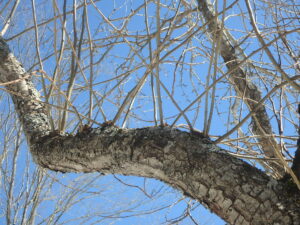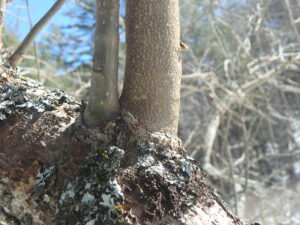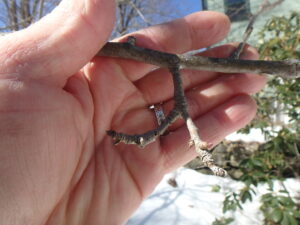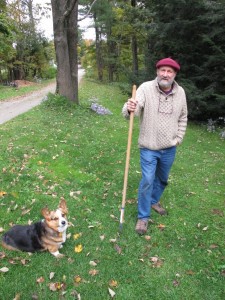It’s Time to Prune Fruit Trees

Pruning saws come in various sizes; loppers are a quick way to cut branches too big for your pruners
Good tools are important for doing a good job. You need sharp by-pass pruners (not the anvil pruners that crush the stems), a pair of good loppers and a small handsaw – folding saws with sharp teeth are good. I have bigger saws for large branches and even a small electric chain saw, but rarely use them.
Water sprouts grow every year on most fruit trees. The first year they are pencil-thin and 12 to 36 inches long. Cut them off as they will just clutter up your tree. Trees grow them in response to a need for more food for the roots, and are most common in shady parts of the tree where leaves are not getting enough sunshine. Some varieties are more prone to growing water sprouts than others, and a hard pruning may stimulate them to grow in large numbers.
Branches often grow away from the center of the tree, as they should, but compete with another branch directly above or below it. Decide which is the better branch, and remove the other. I also look for branches that are headed into the interior of the tree and remove them.
Fruit most often develops on what are called scaffold branches – sturdy branches that leave the trunk on an angle that is almost parallel to the ground, or aiming up slightly. Branches that go more straight up, older water sprouts for example, produce little or no fruit.
Gardening with Aches and Pains
As we get older, most of us develop aches and pains. As gardeners, we need to learn how to move and use our bodies so that we don’t end up feeling like a quarterback after a sacking. I love working as a garden coach, partly because I am, at heart, a school teacher; I also like finding solutions to almost anything. One of my clients, a woman with a bad shoulder, got me thinking about all the tricks I have learned over the years to minimize pain caused by gardening.
My client and I were planting some pretty big hostas. They were in large plastic pots and probably weighed about 15 pounds each. I showed her how to hold the pot upside down in one hand, and smack the bottom of the pot with the other so that the roots and soil would slide out of the pot. But with her bad shoulder, she couldn’t do that.
I taught her to cut open the pot instead. It’s a technique I use when working with trees in pots. I placed the pot on the ground and inserted the blade of my ever-present pruners into one of the drain holes at the bottom of the black plastic pot. I slit up the side to the top, and then sliced again across the bottom. Then I rolled the rootball free of the pot. Finally, I tickled the roots to loosen them up – so they will be ready to explore their new environment.
Getting down on your knees to plant anything (or to pull weeds) is tough if you have arthritic knees or hips. I can recommend a couple of ways to deal with it. My late friend Marguerite Tewksbury, a lifelong organic gardener who lived in Windsor, VT, started carrying a hoe in the garden in her late eighties. She used it not only like a walking stick, it helped her getting down – or up. By leaning on a hoe, you can distribute your weight and make a more stable, 3-point stance.
Of course I am young and healthy at 67, so I don’t need any aids getting down to weed. But sometimes at the end of the day, it’s nice to have something to lean on when on getting up. I like a 5-gallon pail for that, I can push up on it and get up more easily, with less strain on my back. Or sometimes I use my CobraHead weeder to help push me up a little.
Picking beans recently I found bending over tiresome for the length of time I needed to pick all my beans. So I used a 5-gallon pail to sit on. Gardener’s Supply (www.gardeners.com) makes something that looks very good, their “garden kneeler”; it has hand rails at the sides for getting up when kneeling or that allow you to convert it into a seat.
If you suffer from carpal tunnel, pruning may be painful for you. Most manufacturers now make hand pruners with a rotating grip that allegedly minimizes the problem. The Fiskars company has come out with a series of pruners and lopers that offer a different technology – gears to reduce the amount of pressure it takes to make a cut. I have a pair of their biggest loppers, and find them fabulous. The gears really do reduce the work of cutting larger diameter hardwood branches.
One of the most ingenious tools I ever saw used was a homemade corn planter used – and made – by a man in his 90’s. I saw him using it as I drove down the road, and I stopped to talk. He could no longer bend down to plant the seeds, so after his garden was rototilled by his son-in-law, he used a hoe to make a furrow for the seeds. Then he planted using a 30-inch piece of garden hose to get the seeds from his hand to the ground.
The hose poked up through a wide tin can (perhaps a fruit cake or cookie tin). He put all his corn seeds in the can, and then picked them up one at a time and dropped them into the hose (which poked a couple of inches into the can). Then he moved on a few inches and did it again. I’m sure that corn tasted mighty good to him, in part, because he had figured out how to keep on gardening.
Some of my friends who have moved to retirement communities keep their hand in gardening by planting in pots on a deck. Instead of 20 tomato plants, one or two in self-watering containers is what they manage. A pot roughly the size of a 5-gallon pail will do nicely for a tomato – and not have much room for weeds. Smaller pots sitting on railings can handle lettuce or basil very nicely.
If your back bothers you, be careful when hoeing or raking. Don’t lean forward. Keep your back straight. And if you need to pick up a bucket of weeds, place one foot forward and as you bend, tighten your tummy muscles.
None of us is getting any younger. But if you like gardening, you should be able to garden forever. I intend to. Please write or e-mail me if you have a good tip or trick. I’ll post them on my Web site, www.Gardening-Guy.com. Thanks.
Contact Henry at P.O. Box 364 Cornish Flat, NH 03746 or e-mailing him at henry.homeyer@comcast.net. He is the author of 4 gardening books and a recent children’s book about a boy and a cougar, Wobar and the Quest for the Magic Calumet.







